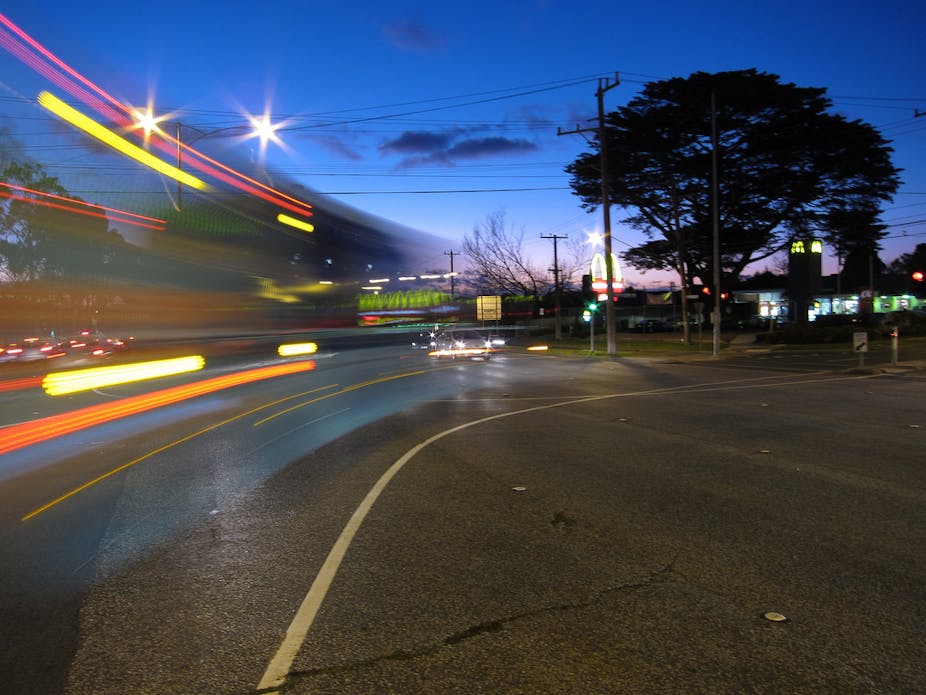Transport accounts for 14% of Australia’s greenhouse gas (GHG) emissions and has one of the fastest emission growth rates. Cutting our national emissions might, therefore, be expected to shine a blowtorch on transport fuels, right?
Well, partly right. For public transport, the news isn’t good.
What’s in, what’s out
The new carbon pricing regime announced this week by the Prime Minister exempts petrol and gives heavy vehicles (greater than 4.5 tonnes gross vehicle mass) a two year moratorium until 2014.
For me, the highlight of the package is the 80% emissions reduction target for 2050. Achieving that target will inevitably require all transport fuels to eventually become subject to a carbon price.
More importantly, it will require a wide range of complementary measures to deliver large and lasting emissions reductions.
Where do all these emissions come from?
The Department of Climate Change and Energy Efficiency’s December 2010, publication, Transport emissions projections 2010, estimates Australian annual transport GHG emissions at an average 85 Mt for the 2008-12 Kyoto Period.
Land transport is the major contributor to transport GHG emissions. Within the 85Mt total, cars account for 41Mt, light commercial vehicles (LCVs) 12 Mt, trucks 18Mt, buses 1.7Mt and rail 2.5 Mt.
The fastest growth in emissions to 2020 is projected to be from trucks (+4Mt). Cars (+3Mt), light commercial vehicles (+2Mt), buses (+0.3Mt) and rail (+0.5Mt) are also projected by DCCEE to show growth.
A major reason for including heavy vehicles within the carbon pricing regime is the high growth rate in truck emissions.
Exempting fuel means less revenue
If the simple assumption is made that trucks and buses run on diesel and that light commercial vehicles use petrol, the direct revenue at $23/t on about 20Mt of heavy vehicle emissions and 2.5Mt of rail emissions is about $500 million annually.
This will increase as the carbon price rises and fossil fuel use increases but reduce marginally as the effect of higher fuel prices from carbon pricing reduces freight volumes. The latter impact is expected to be small, because of low fuel price elasticities.
Exempting petrol means that about $1.2 billion in revenue is foregone (20,000mL of petrol used at ~6c/L carbon price, or 53Mt of GHG emissions at $23/t - both suggest about $1.2 billion revenue forgone annually by exempting petrol). There will also be indirect impacts of carbon pricing on inputs to transport, which need input-output models for their assessment.
Public transport users pay more under a carbon tax
Governments around Australia are all seeking to grow public transport patronage because it can combat the costs of road congestion, reduce high and growing transport greenhouse gas emissions, support social inclusion, improve air quality and lower the road toll.
Putting a price on carbon should support this aim. However, it fails this test when petrol is excluded from the carbon price.
The decision to exempt petrol is understandable in political terms but produces exactly the wrong outcome in terms of giving efficient price signals to travellers. At a time when road users need to be more fully confronted with the costs of their travel choices, an important opportunity has been missed.
Public transport users have been hit from 2014 instead.
Take bus travel in our cities as an example. A carbon price of $23 per tonne will add about 6 cents a litre to diesel prices. Most route buses use diesel.
Route buses in Melbourne travel about 100 million kilometres a year and use about 40mL of diesel. The new carbon price will add about $2.4 million in direct costs, plus additional indirect costs (through the carbon content of inputs).
The total might amount to perhaps $3 million a year. Nationally, buses will be up for about $40 million annually in direct costs (from 1.7Mt emissions).
The end result: fewer bus routes
The way route bus contracts work around Australia, the carbon price on government-contracted (and government provided) route bus services will be passed through to the state government, as a result of the carbon pricing change.
A state may decide to increase public transport fares faster than would otherwise happen, to partly offset this revenue impost. This will mean a loss of public transport patronage and further increases in the costs of road use noted above (such as congestion and greenhouse gas emissions).
It is more likely, however, that a state will forgo future investment in public transport, to compensate for the extra costs of current services because of carbon pricing. This means missing opportunities to not only cut GHG emissions but also to cut congestion costs, lower the road toll and continue to clean our air.
Pay up for public transport
The Federal Government needs to do more to support public transport infrastructure investment. It is necessary to offset the adverse sustainability impact of its decision to exempt petrol but hit public transport (after 2014) with the carbon price.
Longer term, the real answer for reducing land transport GHG emissions is an integrated set of policy measures that:
• reduce the need to travel
• achieve a modal shift to low impact modes and
• ensure that all people have reasonable opportunities for travel.
This set of measures will not only score GHG goals but will also reduce congestion, improve transport health and safety, be better for the environment and promote social inclusion.

